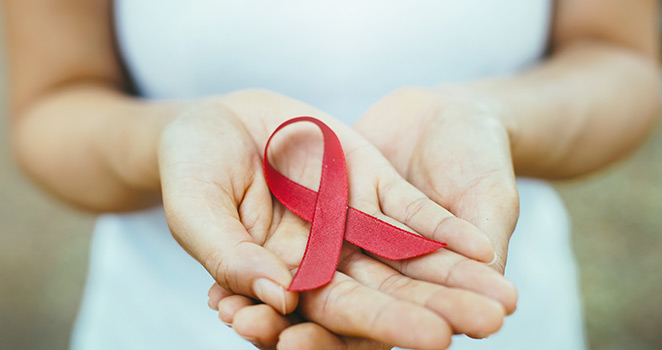Atrium Health Navicent Infectious Disease
HIV/AIDS

Overview
Presently in the United States, about 1.2 million people have contracted HIV, and nearly 1 in 8 probably does not know they have the virus. Though commonly talked about in the same breath, HIV and AIDS are two distinct afflictions. Human Immunodeficiency Virus or HIV is the virus that causes AIDS, or Acquired Immunodeficiency Syndrome, or AIDS. The progression from HIV to AIDS is slow - it can take a decade or more, particularly is the patient is taking Antiretroviral Therapy, or ART, which keeps the virus from reproducing at too quick of a pace. Regardless, however, the both HIV and AIDS can be fatal if not properly treated, as the primary means of reproduction is to attack and infection immune cells in the body, killing them in the process. Through proper education of the transmission of the virus, vigilant use of condoms and other means of sexual protection, and non-participation in activities where tainted needles are used, HIV can be very easy to avoid.
Signs & Symptoms
HIV itself causes mild flu-like symptoms within about 2-4 weeks of contraction. These symptoms can vary, but often include:
- Fever
- Chills
- Body aches
- Nausea
- Headache
- Swollen lymph nodes
- Fatigue
Many times, HIV infection will occur without any obvious symptoms at the start, and once the virus progresses past its initial infectious stage, it enters a latency period where it may not cause any symptoms at all. Often, without knowing through being tested, the only signs of chronic HIV infection are fatigue and recurring infections from having a weakened immune system. This latency period can last a decade or longer, and significantly more if proper treatment with an antiretroviral is being observed. This is why getting tested for HIV is so critical if you are sexually active - proper treatment can delay the onset of major problems from the virus for many, many years, and advances are being made all the time that are showing promise to reverse, remove, or at least significantly impede HIV's progression to AIDS.
If left untreated, or occasionally with time HIV can progress into AIDS. HIV/AIDS weakens your immune system and makes it unlikely to be able to fight off cancers and infections. Without treatment, the average survival rate of someone diagnosed with AIDS is anywhere from 6-12 months. The common day-to-day symptoms of AIDS are:
- Weight loss, often very rapid
- Severe neurological disorders
- Blotches on the skin, particularly around the mouth and nose
- Chronic inflammation of the lymph nodes
- Extreme fatigue
Treatment
There are a variety of treatments, some that are taken within a day of a possible exposure, which can lessen your chances of contracting HIV. These are called post-exposure prophylactics and should be taken within 3 days of possible exposure. Drugs in this category will make your body inhospitable for HIV and often keep it from taking hold. There are immediate courses, and then follow-up courses, later on, to ensure the virus is not reproducing.
If you have contracted HIV and are not eligible for post-exposure treatment, then a daily drug therapy regimen with combo antiretroviral medications is the best course of action to ensure the virus cannot reproduce effectively enough to drastically impair your immune system. This can be difficult, as the emotional ties between taking these drugs and being reminded of the reality of HIV/AIDS can make it hard to take the drugs. People forget or they intentionally put it off, but not taking these drugs daily, at their specific times, can be severely detrimental to the overall effectiveness of the treatment.
Though not a cure, antiretroviral medications can help keep your immune system robust enough to fight off common HIV-related infections or cancers, and restore vitality, reducing fatigue and other symptoms associated with infection.
Prophylaxis
Prevention is much easier now and the main means of transmission are through sex, sharing needles, and blood. HIV is present in sexual fluids and blood, so condom use is one of the best ways to ensure avoiding the virus. Not sharing needles, as with intravenous drug use, or through homemade tattoos, is another way to be certain you are not exposed. Unlike the early days of HIV, before it was well understood how the virus was transmitted, many people contracted it through blood transfusions but thankfully with proper screening, this rate is nearly 0% in the US. Post-exposure therapy is another way to make sure that you do not contract the virus.
Prognosis
Though it used to be a death sentence, HIV is more of a chronic health condition if treated. With a proper drug regimen and a healthy lifestyle, a newly diagnosed young adult can easily live another 20-50 years, which in most cases puts them nearly at the national average for non-infected people. With AIDS, even when treated, the prognosis is not favorable; with the average additional lifespan being somewhere between 5 and 40 years, but proper care and treatment brings the potential lifespan up considerably, with untreated HIV being about a 10 years of life and untreated AIDS being closer to a few months. Being on top of the infection, and all opportunistic infections that might arise because of a weakened immune system, people with HIV/AIDS can live normal lives, and proper drug therapy can greatly reduce the risk of passing the virus onto others, given that proper protection is used under normal circumstances.